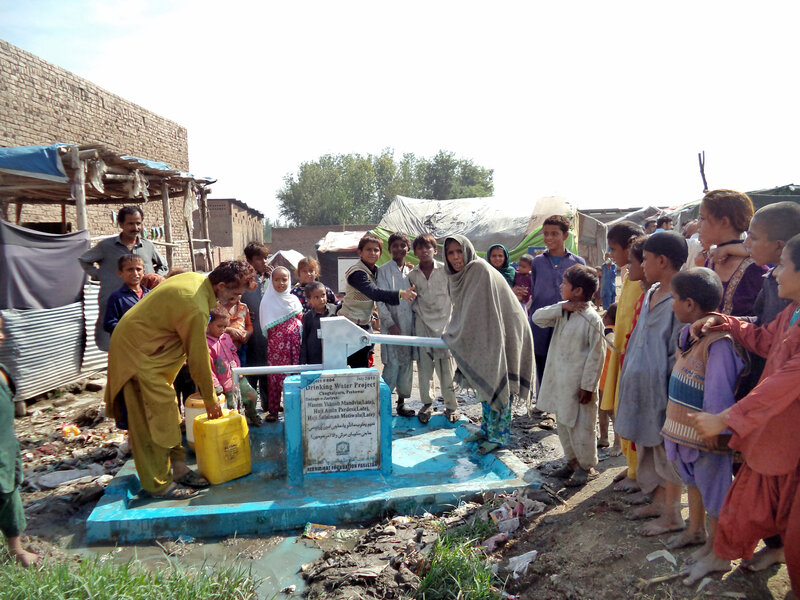In Pakistan, sanitation and water access improves quality of life
| Peshawar, Pakistan
In Pakistan, lack of access to sanitary facilities and clean water can hinder even the simplest of daily tasks. In particular, low-income women say they often run the risk of being sexually harassed when fetching water or when they are forced to openly defecate.
For Allah Wasai, a woman living in a makeshift settlement of tents in the southern area of the city of Peshawar, harassment was a daily occurrence when she did household work. “I used to fetch water for washing, cooking, and drinking from a canal. The harassers used to annoy me along the way,” she says. To avoid them, she adopted an erratic schedule for her chores. Robina Bibi, another woman from the tent settlement, says she was grabbed by men swimming in the canal when she went to collect water.
Ms. Wasai’s and Ms. Bibi’s situations are not uncommon in Pakistan. In 2018, the nonprofit WaterAid reported that approximately 20 percent of the country’s poorest citizens do not have access to clean water close to their homes.
Meanwhile, when third-grader Nasra Ilyas went to primary school each day, she often found the toilets there were clogged and overflowing. The situation meant a humiliating and dangerous experience any time she needed to relieve herself. “Because of the dysfunctional toilets, I answered the call of the nature in the open,” she says. “A young boy passing through the street made vulgar comments.” After the experience, she says she stopped eating or drinking before school so that it would never happen again.
Lack of toilets in schools is a widespread global issue. In 2018, WaterAid reported that 1 in 5 primary schools and 1 in 8 secondary schools worldwide do not have any toilets. It’s a problem that disproportionately affects developing African and Asian countries with booming populations.
But Wasai, Bibi, and Nasra have benefited from a spate of improvements to water sources and sanitary facilities made in Pakistan in the past few years. Hizbullah Khan, chairman of the environmental sciences department at the University of Peshawar, says nongovernmental organizations such as WASH, UNICEF, and WaterAid Pakistan have helped raise awareness of the need for improvements. “Access to clean drinking water ... prevents people [from contracting] water-borne diseases and [shields] women from harassment,” he adds.
While NGOs have helped draw attention to water and sanitation issues, on-the-ground solutions have also been implemented by local organizations and governments. In Nasra’s primary school in Peshawar, four toilets constructed in 2016 now provide a safe facility for her and other schoolchildren. They were built by the government of the Khyber Pakhtunkhwa (KP) province, where Peshawar is located, thanks to efforts of the centrist Pakistan Tehreek-e-Insaf (PTI) party. According to Zia Ullah Bangash, an adviser to the chief minister in KP, the PTI government is acknowledging its responsibility to provide basic facilities – including water and toilets – in state-run schools. Mr. Bangash says the toilets in Nasra’s school are among some 37,700 built in government schools in KP between 2014 and 2018; more than 12,000 schools have received water and sanitation facilities.
And the Alkhidmat Foundation – a nonprofit organization with a grass-roots network that provides humanitarian relief across Pakistan – installed a hand pump in Wasai’s Peshawar tent settlement. She and other women can use it close to their homes, instead of facing harassers on the way to the canal.
Syed Adil Hussain manages the Alkhidmat Foundation’s Clean Water program for KP. He says the water source placed in the tent settlement was one of 2,300 hand pumps, filtration plants, and wells installed by his organization in KP between 2014 and 2017. In Peshawar alone, the organization has installed 300 pumps.
Overall, Pakistan has seen marked improvement in providing access to clean water. In 2018, WaterAid ranked it the fifth most improved in water access worldwide, determined by the number of people reached: More than 44.3 million people gained sources of water.
While humanitarian concerns are being addressed, environmental concerns remain. Scientists warn that the new demands on the water table could cause a water shortage as soon as 2025.
Nevertheless, Mr. Hussain emphasizes that improved access to water, sanitation, and toilets reduces harassment, ensures dignity for women, and prevents diseases. Most importantly, he says, it has improved Pakistan’s reputation.
In the tent settlement, Wasai is reaping the benefits of the hand pump. “[It] protected us from the [harassment] and ensured a secured environment,” she says.






